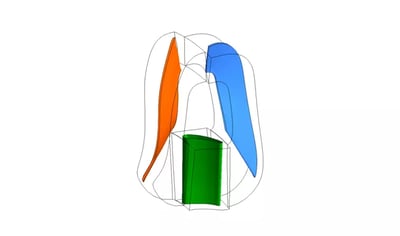Torque converters are quite atypical turbomachinery, they feature recirculating flow from the pump into the turbine, through the stator and back into the pump.
This means that there is a very high interaction between the stages and changes to one component, such as the pump impeller, could create an entirely different flow field back into the pump impeller. It has become common practice to mainly rely on stator optimization, although major efficiency improvements can be achieved by optimizing all three components simultaneously.

Fig. 1. Torque Converter.
For this project, ADT engineers were tasked to redesign an existing torque converter for a leading automotive manufacturer. The existing design performance was used as a reference baseline, but specifications regarding the number of blades and input speed were left to ADT’s choice during the optimization.
It is essential during a torque converter design phase to maintain both the pump and turbine head at the specific volume flow rate and also the inlet and outlet conditions of each component at every design iteration. The risk is that mismatch between the components may cause incidence losses and deteriorate the torque converter performance.
Using TURBOdesign1 the inflow and outflow distribution at each blade row, effectively the spanwise work distribution at the leading edge and trailing edge of each blade, are input in for each component and maintained throughout each and every design iteration. This is a major benefit during the design and optimization process, and it allows designers to directly control the hydrodynamic performance of the components.
A first design using TURBOdesign1 was generated as a starting point for the optimization, where the design input parameters followed the generally established design guidelines illustrated below.

Fig. 2. Streamwise loading used for the baseline stator, pump and turbine respectively.
The stator features a mid-loaded distribution, while the pump is clearly aft-loaded to reduce profile losses. The turbine features a fore-loaded hub and aft-loaded shroud to control secondary flows.
To see the results of the initial design and the optimization of the entire torque converter, we invite you to download your free copy of this consultancy summary below:
Mehrdad Zangeneh
Mehrdad Zangeneh is Founder and Managing Director of Advanced Design Technology and professor of Thermofluids at University College London.
View All Articles







Share This Post